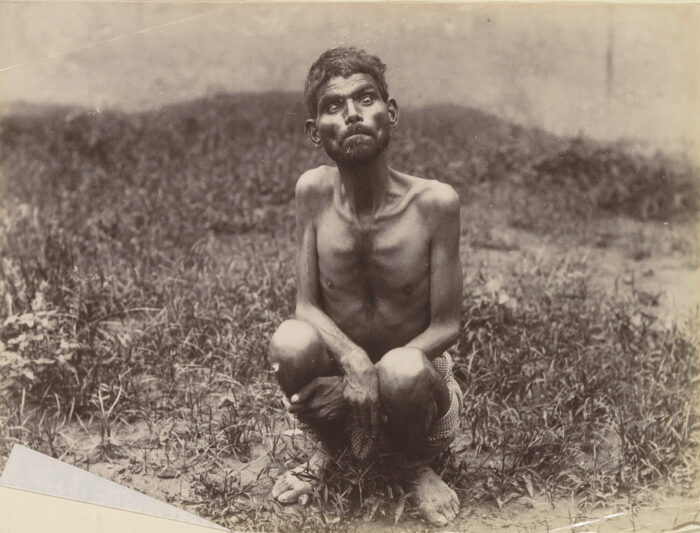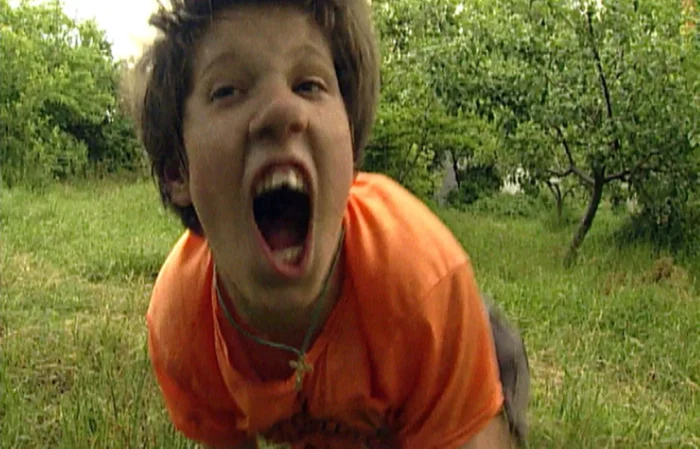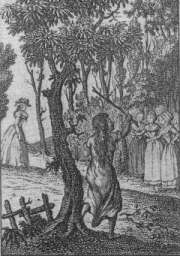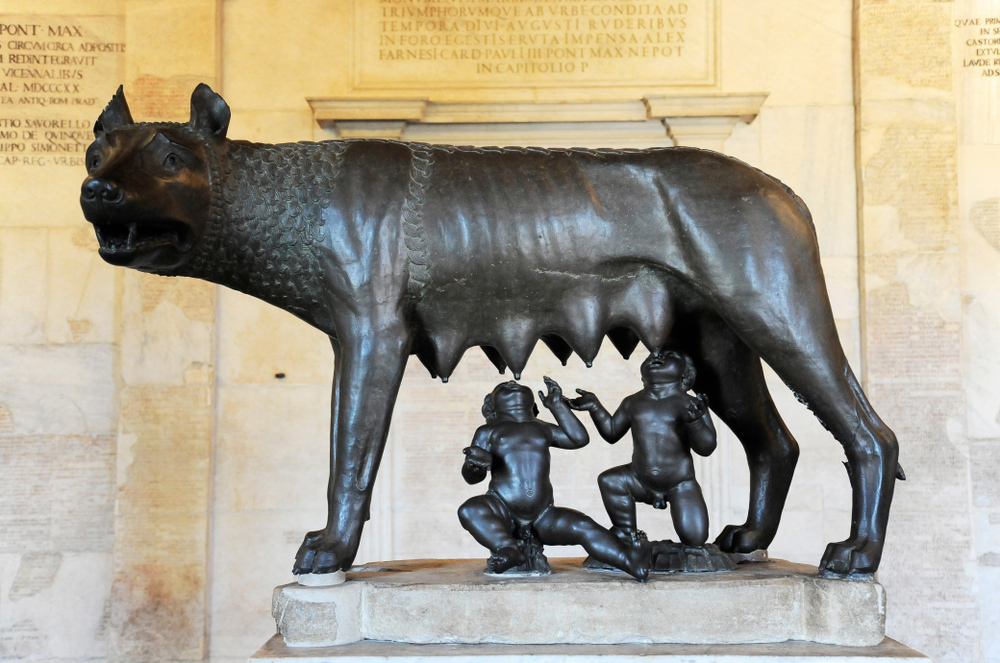Sometimes, extraordinary circumstances cause children to become isolated in the wilderness for years without a human caregiver. This is a common subject of legend —Romulus and Remus, Mowgli, Tarzan.
Some real children have also joined packs of animals. Unlike fictional children, who often acquired some of the bush savvy of their adopted kin, the experience stunts the mental, emotional, and linguistic faculties of these castaways. Some early psychologists mistook their damaged state for what they called idiocy or madness.
Victor of Aveyron
Victor of Aveyron was a nine-year-old feral child who came to the attention of French authorities in the late 1790s. Hunters tried to capture him, but he evaded them. Eventually, the authorities caught him in 1800. He was covered in scars, made animal-like sounds, was completely naked, walked on all fours, and relieved himself in public. The public called him the enfant sauvage de l’Aveyron — the wild child of Aveyron.

Victor of Aveyron. Photo: Unknown
His origins are a mystery. No relatives or friends came forward to claim him, and he remained in the state’s care. Some theorized that he was an illegitimate child abandoned by his parents; others, that he was a survivor of the chaos of the French Revolution.
Doctors observed that Victor disliked clothes and was very acclimatized to the cold. He could not speak and learned only a few French words. He also tried to escape society back to his wild, singleton state.
One of Victor’s more romantic caretakers believed that he was an example of an uncorrupted soul. While Victor could communicate little, he showed empathy for those around him, such as offering comfort to someone crying.
One theory of the time suggested that Victor was autistic. Autism research and special education for mentally disabled children only began in the 1790s, and Victor was a ground-breaking case study. Psychologist Jean-Marc Gaspard Itard developed a special recovery program for Victor that included sensory and physical exercises. These were supposed to increase his cognitive faculties and encourage him to form interpersonal relationships with others. However, Victor showed little progress.
In 1828, Victor died around age 40 from pneumonia. He never learned to speak, and he had not integrated into society.
Dina Sanichar
In some ways, Dina Sanichar was the Indian version of Victor. In 1867, hunters exploring the jungle around Bulandshahr, India, discovered a large cave. Inside, they found a six-year-old boy who walked on all fours and barked and howled like a dog. They found him with a wolf pack. They killed the she-wolf and took the child to an orphanage.
Here, he received a name, clothes, and food. Some tried to educate him.
The transition proved very difficult for Sanichar. He could not speak except to growl, howl, and bark. Christian missionaries attempted to teach him how to speak and walk upright. It took a very long time, but he learned to walk and wear clothes. His speech, however, remained completely impaired. He only communicated with gestures.

Dina Sanichar as an adult. Photo: Rijksmuseum
Sanichar did make a friend in the orphanage, another feral boy. Feral children were quite common at the time, leading to several folk tales and stories. Perhaps the most famous was Rudyard Kipling’s The Jungle Book, in which wolves raised the boy Mowgli.
As an adult, Sanichar did not speak but developed an affinity for cigarettes. He died at just 34 from tuberculosis.
Oxana Malaya
More recently, Oxana Malaya is a feral Ukrainian girl raised by dogs in the 1980s. At the age of three, Oxana suffered abuse from her alcoholic parents. They neglected her basic needs and often shut her out of their home. Their excuse was that they had too many children.
As a result, the toddler found a surrogate home with a pack of stray dogs. Instead of speaking, Oxana growled, barked, and walked on all fours. The dogs protected her from harm. With the pack, she learned to clean herself, sleep on the floor, eat, and rummage for food.

Oxana Malaya acting like a dog. Photo: BBC Channel 4
Malaya survived like this for over four years until a neighbor reported her to the authorities, and the state placed her in foster care. Incredibly, her rehabilitation proved relatively successful. She regained her ability to speak and write.
Today, Malaya lives at a home for disabled people. She works at a farm and has even built human relationships. She is in touch with her siblings, who also suffered neglect. About 10 years ago, she gave an interview on Ukrainian television in which she seemed quite articulate and comfortable in her own skin. She even smiled several times. However, psychologists believe she may never lead a normal life because of the early abuse.
Marina Chapman
In the 1950s, during one of the most devastating periods in Colombian history, a little girl was kidnapped from her village and left alone in the jungle. Marina Chapman believes she was approached by two people who chloroformed her near her home at the age of five.

Marina Chapman climbing a tree. Photo: All That’s Interesting
Left alone in the jungle, a band of capuchin monkeys adopted Chapman. She lived with them for five years, feeding mainly on fruits. She grew adept at climbing trees, finding food, and communicating like the capuchins. She explained how the monkeys cared for her when she got sick with food poisoning. Eventually, hunters found her. But they did not have good intentions.
Instead of reporting Chapman to the authorities, the hunters sold her to a brothel. She lived on the streets for a time and then as a slave to a mafia family. While some view the story as farfetched, Chapman swears it is true. Critics believe her trauma created false memories.
Later Chapman’s former neighbor’s daughter adopted her, taking her to the UK where she could start over. Chapman married and now lives a normal life.
Wild Girl of Champagne
Marie-Angelique Memmie Le Blanc gained notoriety in the 18th century, a few decades before the French Revolution. At age 19, she was caught by hunters while stealing apples from an orchard in the village of Songy in Champagne, France. She had been roaming the wild since she was 10.
She was not animalistic but rather acted as a hunter and a gatherer. She was very skilled at obtaining food, usually stealing and foraging. She was on constant alert. She wore rags and animal skins for warmth. Her diet consisted of fruits, vegetables, and raw meat. She did not speak.
While animals may have adopted other feral children, Le Blanc spent much of her time fighting them off. She carried a wooden club for protection.
Word of the feral girl spread, even reaching the King and Queen of France. They ordered her capture, wishing her to be reassimilated into society. The case became a media sensation, and many Enlightenment thinkers wanted to study her.

Wild Girl of Champagne. Photo: Unknown
Le Blanc became literate and joined a convent in her adulthood. Her fame also led to substantial wealth.
Many years later, researchers believe they pieced together who Le Blanc was and where she came from. Supposedly, she was a Native American from America or Canada. Someone abducted her but died of the plague while returning with her to France. She then wandered the wilderness, left to her own devices.
Notable hoaxes
While these stories are real, many other tales of feral children were not. There were a few hoaxes concerning wolf children in India, perhaps encouraged by the tale of Dina Sanichar. In the 1920s, two girls from Bengal named Kamala and Amala (eight years old and 18 months old respectively) gained notoriety in this way. Allegedly, a clergyman found them. He claimed their parents abandoned them, and a she-wolf subsequently raised them. However, the clergyman falsified the story for monetary gain.
The story of the Syrian Gazelle Boy was not a deliberate hoax but a misunderstanding. In 1946, the Iraqi Army found a 10-year-old boy wandering around with a herd of gazelles. They claimed to see him running at impressively fast speeds of up to 50km per hour and assumed the gazelles had raised him. Unsurprisingly, the story turned out to be untrue.





